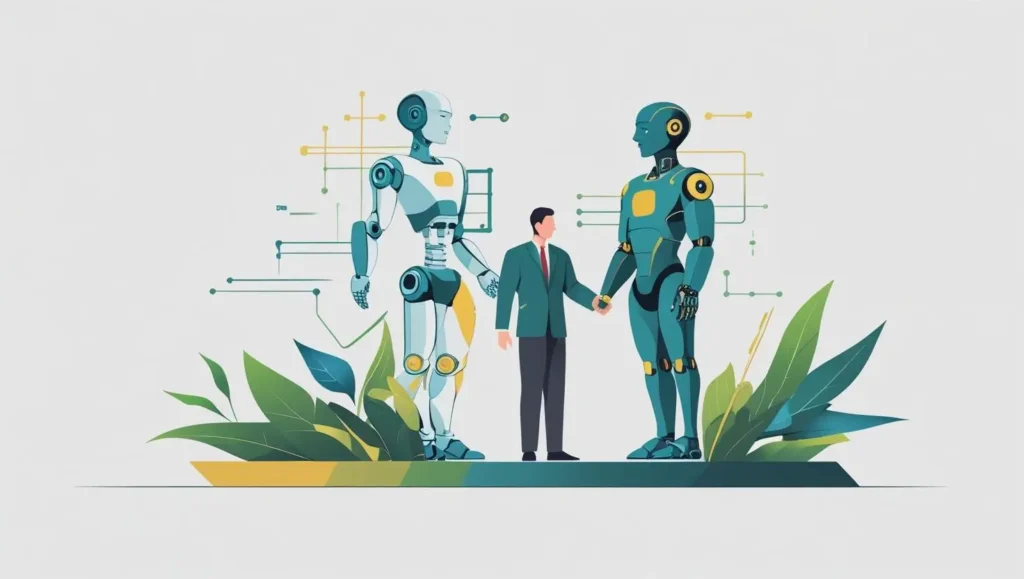
“AI won’t replace leaders — but leaders who use AI will replace those who don’t.”
The skills that once defined leadership have undergone a massive transformation. Artificial intelligence, automation, and hybrid work models are rewriting the leadership playbook at an unprecedented pace. Communication has become faster yet more fragile. Processes are no longer static and manual; they are automated, reengineered, and constantly evolving. What brought success yesterday seems to be falling short today. The Future of Leadership requires adaptability and innovation.
This tectonic shift is forcing organizations and individuals alike to rethink the very meaning of leadership. Titles, authority, and traditional management approaches are no longer enough. Real leadership in the age of AI is not about competing with technology—it’s about blending technological fluency with timeless human strengths like vision, empathy, and ethical judgment.
As we navigate this new landscape, it’s essential to understand that the Future of Leadership is not just about leveraging technology but also about fostering human connections and ethical practices.
How AI Is Redefining Leadership & Work
Leadership has continually evolved with technology—from the printing press to the steam engine, from email to globalization. But artificial intelligence represents a different kind of shift. Unlike earlier innovations that changed tools of work, AI is reshaping the very nature of leadership itself.
From Intuition to Intelligence-Driven Decisions
For generations, leadership was often anchored in intuition—an ability to “read the room,” spot trends, and make judgment calls. That instinct still matters, but today leaders are surrounded by a flood of real-time data, predictive algorithms, and automated insights. The challenge is not having enough information—it is knowing which signals to trust, how to balance quantitative predictions with qualitative understanding, and when to act on human instinct despite what the data suggests.
Automation and the Shifting Leadership Focus
Given that machines have taken over repetitive and transactional tasks to a great extent, leaders are freed from operational clutter. That freedom, however, comes with pressure. Leaders are expected to spend less time approving expenses or managing schedules and more time clarifying purpose, asking sharper questions, and cultivating innovation. In other words, leadership is shifting from managing efficiency to mobilizing creativity.
Hybrid Work and the Test of Influence
The pandemic accelerated hybrid work, but AI is now making distributed collaboration seamless and more complex. Tools can coordinate across time zones, but they cannot create trust. They can monitor productivity, but they cannot inspire loyalty. Leadership in such an environment has become about influence without proximity. The most effective leaders are those who can build cohesion, maintain clarity, and foster belonging in teams that rarely share the same physical space.
Ethical Stewardship in an Algorithmic Age
One of the least discussed—but most critical—impacts of AI is the ethical dimension it brings to leadership. Questions around data privacy, hidden bias in algorithms, or whether automation displaces jobs are not just technical debates; they are profoundly human and moral choices. Leaders who downplay these responsibilities risk more than compliance issues; they risk losing the trust of employees, customers, and even the society that grants them legitimacy.
And here lies the paradox: AI is not reducing the need for leadership; it is magnifying it. Technology may deliver speed, scale, and efficiency, but only leadership can provide judgment, empathy, and vision. The leaders who succeed will not be the ones trying to outpace machines, but those wise enough to guide them—and human enough to balance what algorithms cannot.
Skills Leaders Need to Stay Relevant
If AI is rewriting the playbook of leadership, then the leaders who remain relevant will be those who rewrite themselves. Technology may amplify what organizations can do, but it is leadership that determines why and how those capabilities are used. The leaders of tomorrow will need a different set of muscles—some new, some timeless, all sharpened for an AI-shaped workplace.
Technological Fluency Without Losing Perspective
Leaders do not need to become data scientists or machine-learning engineers. But they do need fluency—the ability to understand what AI can do, where it is limited, and how to apply it responsibly. A leader who cannot speak the language of technology risks being sidelined in strategic discussions. At the same time, fluency must never be confused with obsession. The best leaders treat AI as an enabler, not a master.
Even leading researchers argue that AI, when used thoughtfully, can sharpen—not weaken—our leadership capabilities. As one Harvard Business Review article notes, the future of leadership may be less about resisting AI and more about learning how it can make us better leaders.
Adaptive Thinking in a World of Constant Flux
AI accelerates change at a pace most organizations struggle to absorb. What seems like a cutting-edge strategy today may be obsolete tomorrow. Leaders who thrive will not be those who chase every new tool, but those who can adapt their thinking—questioning assumptions, pivoting strategies, and staying resilient in uncertainty. Adaptive thinking is less about having the correct answers and more about asking the right questions at the right time.
Emotional Intelligence and Human Connection
As technology automates tasks, what remains distinctly human is the ability to connect. Emotional intelligence—the ability to read context, listen deeply, and empathize with diverse perspectives—becomes even more valuable in a digital workplace. In an era where employees might interact more with systems than supervisors, leaders must work harder to humanize work: to inspire, to motivate, and to remind people of their significance beyond productivity metrics.
Vision-Centric Leadership
AI can optimize processes, but it cannot craft purpose. Algorithms can find patterns, but they cannot paint a picture of where an organization is headed and why it matters. That responsibility falls squarely on leaders. A clear, compelling vision—one that gives employees a sense of meaning—anchors organizations amid the noise of constant technological disruption. Leaders who fail to articulate a vision risk creating teams that are efficient but directionless.
The paradox of AI is this: the more technology advances, the more human leadership must become. Leaders who cultivate fluency, adaptability, emotional intelligence, and vision are not just staying relevant—they are shaping the future of work itself.
The Human Edge AI Can’t Replace
Technology may become faster, wiser, and more precise, but it cannot replicate what makes leadership profoundly human. AI can process data, but it cannot create meaning. It can optimize operations, but it cannot inspire commitment. The leaders who will stand out in the years ahead are those who double down on the qualities no algorithm can reproduce.
Storytelling and the Power of Meaning
AI can generate reports and dashboards, but only leaders can transform raw information into a narrative that inspires action. A great leader does not just share numbers; they explain why the numbers matter and how they connect to a larger purpose. Storytelling is not ornamental—it is the bridge between data and belief, the difference between compliance and genuine engagement.
Trust and Ethical Judgment
Trust is earned through consistency, fairness, and moral courage. These are not outputs that an algorithm can deliver. Leaders today face ethical dilemmas ranging from how AI decisions are made to how employees are treated in times of automation. Choosing the “efficient” option may be easy for technology, but it is leaders who must weigh efficiency against humanity. Trust, once broken, cannot be restored by code.
Creativity and Strategic Imagination
AI is powerful at finding patterns in the past; it struggles to imagine futures that do not yet exist. That is the domain of human creativity. Leaders provide strategic imagination—the ability to see opportunities before they are apparent, to challenge the status quo, and to craft possibilities that data alone cannot reveal. It is not just about solving today’s problems, but about envisioning tomorrow’s opportunities.
Culture-Building and Human Connection
Organizations are more than systems; they are communities. Culture emerges from values lived daily, trust reinforced in small moments, and a shared sense of belonging. No AI tool can create a culture where people feel valued, safe, and motivated. Leaders who intentionally build culture—through recognition, inclusion, and genuine care—provide an irreplaceable human edge.
The paradox is apparent: the more AI automates, the more irreplaceable these human dimensions become. In the end, what separates exceptional leaders from competent managers in the AI era will not be how well they use technology alone, but how deeply they preserve—and elevate—the human spirit of leadership.
While AI can streamline processes, it is the timeless human qualities—like communication, empathy, and adaptability—that truly drive career growth. These 5 soft skills remain just as critical in the AI era as ever.
Practical Steps to Future-Proof Your Career
The conversation about AI and leadership is not abstract—it is already shaping careers, boardrooms, and industries. Leaders who want to stay relevant cannot afford to simply “wait and see.” The good news: the future does not belong to those who know everything about AI. It belongs to those who learn continuously, adapt intentionally, and integrate technology without losing their human edge. Here are four practical steps to begin that journey.
1. Invest in Lifelong Learning and Upskilling
AI is advancing faster than any single degree or credential can keep pace with. The leaders who thrive will be those who treat learning as an ongoing discipline. This does not mean enrolling in every new certification—it means building a habit of curiosity. Explore how AI tools are reshaping your industry, understand their limitations, and experiment with them firsthand. Staying future-ready requires shifting from “learning once” to “learning always.”
2. Build Cross-Disciplinary Networks
AI does not operate in silos, and neither should leaders. Future-proof careers are built through collaboration across functions, industries, and even disciplines. A finance leader who understands behavioral psychology, or a healthcare leader who grasps data ethics, brings insights that machines cannot replicate. Networks are not just for opportunities; they are laboratories for cross-pollination of ideas.
3. Balance Efficiency with Well-Being
AI promises efficiency—but unchecked efficiency can breed burnout. Leaders who sustain long-term impact recognize that well-being is not a luxury; it is a performance multiplier. Protecting personal boundaries, modeling healthy habits, and encouraging sustainable work rhythms ensure that teams can thrive in a future where “always-on” technology tempts people to become “always working.”
4. Lead With Purpose, Not Just Processes
AI will continuously optimize how work is done. Leaders must answer the deeper question: why it is being done. Aligning technological adoption with organizational purpose ensures that teams don’t feel like they are serving machines, but rather that technology is serving a greater mission. Purpose provides the emotional anchor that algorithms cannot offer.
The future of leadership does not belong to those who master every new tool. It belongs to those who cultivate adaptability, connect meaningfully, and lead with purpose—while using AI as a partner, not a replacement.
Case Insight: Leading Transformation in the Age of AI
Consider the case of a senior operations leader in a multinational logistics firm. It is a role that was historically defined by efficiency, schedules, and supply chain predictability. For years, his leadership success came from operational expertise and the ability to coordinate large teams across multiple locations.
When AI-driven systems were introduced—automating demand forecasting, route optimization, and warehouse management—the very foundations of his role shifted. The traditional levers of leadership he had relied on suddenly became less relevant. At first, he resisted, fearing that AI would erode his authority. But over time, he reframed the challenge.
Instead of competing with the system, he began asking a different set of questions:
- How can AI free my team from repetitive problem-solving so they can focus on innovation?
- What cultural changes must I drive to ensure people trust AI insights without losing their critical thinking?
- How do I communicate our new capabilities to customers in a way that builds confidence, not confusion?
His transformation was not about mastering the technical architecture of AI, but about blending it with human leadership. He invested time in upskilling—not just in technology but in design thinking and change management. He worked deliberately to maintain morale by showing his teams that AI was not replacing them but amplifying their contributions. Most importantly, he redefined his role: no longer the “guardian of efficiency,” but the “architect of innovation and trust.”
This shift produced measurable results. Customer satisfaction improved because operations became faster and more transparent. Employee engagement scores rose as workers felt their creativity and judgment were valued, not replaced. And his leadership reputation grew stronger because he demonstrated what many leaders today must embrace: adaptability, curiosity, and, most importantly, a clear sense of purpose.
Conclusion: Leading Beyond the Algorithm
AI is no longer a distant disruptor; it is a present reality reshaping every corner of leadership and work. Yet the lesson is clear: technology may change the context of leadership, but it cannot change its essence. The leaders who thrive in this new era are not those who fear AI or those who unquestioningly worship it. They are those who see it for what it is—an extraordinary tool that demands extraordinary leadership.
The true challenge of the AI era is not technological adoption; it is human adaptation. Leaders must cultivate fluency in emerging tools, but they must also double down on the qualities that make them distinctly human: vision, empathy, creativity, and ethical courage. This combination—not one or the other—will define relevance in the years ahead.
For organizations, this is more than a matter of staying competitive. It is about sustaining trust, building cultures that people want to belong to, and using technology in the service of a greater purpose. For individual leaders, it is about choosing growth over comfort, curiosity over complacency, and courage over control.
In the end, AI will not replace leaders. But it will redraw the line between those who merely manage change and those who create the future. The leaders who rise will be the ones who ask better questions, inspire deeper trust, and remind their teams of something no machine can provide: the human spirit that turns progress into possibility.
Every insight comes with a journey. Here’s mine.
Have questions or perspectives of your own? Reach out here.
Disclaimer: This article is based on personal experience and insights. It does not constitute financial, legal, or medical advice.




